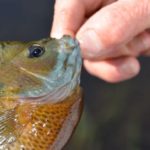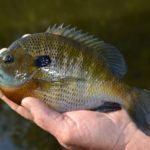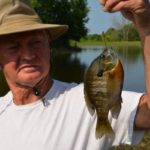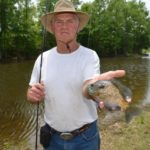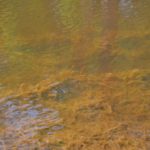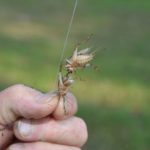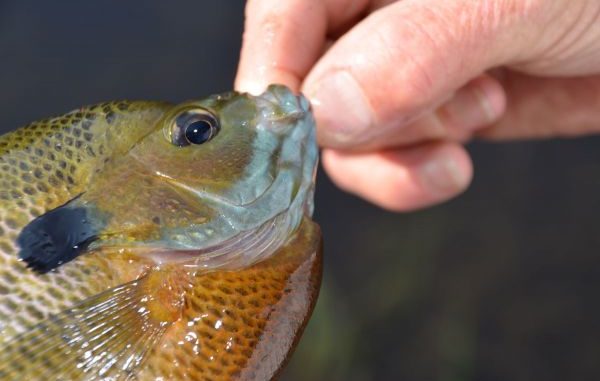
Sometimes you can hardly keep bream out of your boat, but when the bite gets tough you have to know how to adjust. Here are some tips from a man who has perfected the art of catching these tasty panfish.
“Ain’t nuttin’ to it,” drawled the lanky 68-year-old. “Ya just find a bed of ’em and ketch ’em.”
If only it was that easy.
A lot of people catch a few bream; only a few people catch a lot of them.
I turned to the best bream fisherman I know for the secrets on how to catch large numbers of them consistently. Charles Johnson lives north of St. Francisville, and fishes throughout Louisiana and Mississippi.
The word “bream” can take in a lot of ground. For some purists, bream means only one species of sunfish — the bluegill. For most of the rest of us, bream can mean any one or all of the nine species of sunfish found in the two states, including chinquapins, goggle-eyes, slick perch and sun perch.
Bluegills are most pursued because they are most common, they form spawning beds populated by sometimes over 100 ravenous males and their spawning season lasts all summer.
All that makes it sound like it would be easy to load an ice chest with them.
But it ain’t that easy.
“Big bream are spooky. Most people underestimate the skill it takes to catch big bream,” Johnson said with a note of respect in his voice. “Yes indeed.”
Johnson grabbed his rod, some crickets and worms, and we headed to one of his favorite fishing holes for some on-the-job training. Interestingly, while he planned to spend some time in a boat, most of his fishing would be done from the bank, sneaking up on bream bedded in just a few inches of water.
“Shhh,” he cautioned as we crept up to a bream bed he had been fishing for a couple of weeks.
His cork bobbled as soon as it hit the water, indicating a fish had picked up his bait.
He gave a subdued grunt as his long rod arched over and the fish ran in frantic, ever-tightening, corkscrew-like circles. It was a big, colorful, spawning male bluegill.
He admired it as he unhooked it.
“Any time they get that hump back they are good bream,” he said.
From there the game was on.
There are certainly bigger and arguably more-glamorous freshwater fish than bream. There are no bream tournaments. There is no Bream Anglers Sportsman Society.
So why fish for bream?
Johnson masked his disdain for the question as he patiently answered.
“Ounce for ounce, there ain’t much more of a fighter than a bluegill,” he said. “They are fighting suckers. And they are good to eat.
“My favorite fish to catch is sac-a-lait. My favorite fish to eat is bream. I only fish bass when nothing else is biting.”
Bold words from a guy with a 10-pound, 1-ounce bass on the wall.
“I eat fish three times a week, mostly fried. I’m a real redneck about frying fish,” he said with a grin. “Bull bream (the males) are fatter and taste best early in the spawning season. They get plumb strong up in the summer. Sometimes I get away from the beds of males and go looking for females.
“Bluegills are the best eating. Chinquapin are good, but bluegills are better. I prefer bluegills to goggle-eyes, too. Goggle-eyes have a softer texture. Of course, I eat any fish except carp; I don’t eat carp.”
Bream can be challenging to catch, too, he explained. If the fish on a bed get any amount of fishing pressure or if water levels over their beds drop, leaving the fish feeling exposed, they become spooky.
Sometimes Johnson can only fool them with a baited hook — no weight and no cork.
The bream on one particular bed in very shallow, clear water proved the point. After quickly taking several males off the bed by selectively sight-casting to them, the other nest-guarding males refused to take his offerings.
“I’ve never seen it where I can’t get a bluegill to bite a cricket,” he said incredulously. “I’m putting it right in their mouths.”
Finally, after showing incredible patience, he managed to screw another one of the brilliant little peacocks out of the water.
Here are some more thoughts on how this prove bream-killer consistently puts bream in his ice chest.
When to go bream fishing
“Bream spawn all summer,” Charles Johnson said. “Chinquapins (aka redear sunfish or lake runners) spawn before bluegills — March, especially late March. The time of year doesn’t have nearly as much to do with it as does water temperature, but late March is usually best.
“When chinquapin aren’t on their spawning beds, they are the devil to catch.”
Bluegills, he explained, begin spawning in late April and continue through August.
Like other bream, male bluegills will sweep out depressions in the bottom with their fins. On sandy bottoms these nests can be very easy to spot because the bright, clean sand contrasts with the surrounding bottom. In grassy areas, beds are simply depressions in the grass that can be hard to see.
“People talk about catching bass off of (spawning) beds; they are catching males,” Johnson said. “Same thing with bream — the ones on the nests are males.”
While bluegills spawn all summer, they move their nests into deeper water as the summer wears on. In the spring, the beds will be in less than a foot of water. By mid-summer they are 3 feet deep.
Time of day is also a factor. Johnson firmly believes the best hours to fish for bedded bream are noon to 4 p.m., especially early in the season when water temperatures are lower.
“There is no doubt that you will get more action in the middle of the day,” he said.
Where to fish bream
Charles Johnson is quick to admit that not all waters are equally good for producing big bull bream.
“In some lakes and ponds, bream get big; in some they don’t,” he said. “I don’t understand why. My theory is that in big lakes, where bass are fished heavily, bream don’t get big. They get overpopulated.”
He cited Lake Bruin and Mississippi’s Lake Lincoln as examples of lakes where conditions seem perfect, but bream don’t grow large.
About all a fisherman can do, besides listening to other anglers’ reports, is go fish the water body. Within any water system, bream prefer to spawn in protected locations over areas open to a lot of wave action or water currents.
Bottom type also matters. Bluegills, in particular, prefer firm bottoms instead of very soft or slushy bottoms. Bottom type can vary tremendously over a short stretch of shoreline, sometimes only several hundred yards apart.
Lakes and canals that produce big bulls one year will do so year after year. Those that produce small spawning male bream will do likewise.
How to find bream beds
“I find bream beds in the spring moving by slowly along a shoreline in a boat and looking for whirls of water in the shallows made by the males building their nests,” bream-killing expert Charles Johnson said. “If you catch a couple of big males in one spot, you have found a bed. Sometimes the beds are small and only hold a few males; others will hold hundreds in one bed.
“When they stop biting, I move the boat slowly and look for more action.”
Both bluegills and chinquapins tend to bed in the same spots year after year unless something in the spot changes, Johnson said.
This is particularly true of water levels. Because of the loyalty of bream to certain spots, fisherman who fish the same water body year after year will be more successful than newcomers.
Johnson encouraged fishermen to get out early in the spawning season to find and hit bream beads.
“The first couple of days after they get on their beds you can catch them on anything,” he explained. “It doesn’t take any skill at all.”
A dead giveaway to locating a bream bed is seeing little clusters of bubbles coming up from the bottom.
“They make those when they’re building their nests,” Johnson said. “When I see that, I know I’m fixing to catch a big old mess of bream. They’re going to be biting.
“You got to be sure they’re not just any old kind of bubbles, though.”
While Johnson is a firm believer that live bait is the best choice for bream fishing, he sometimes uses artificials to find fish. His favorite is a blue-and-white or black-and-chartreuse tube jig on a 1/32-ounce jighead.
He sets his jig under a small pear-shaped cork, which he insists gives the jig an irresistible bobble as it is retrieved with twitches.
“You cover a lot of water with a jig and cork,” he explained. “But when I catch a bull bream, I know it’s time to put a cricket or worm on a hook on another rod.”
What is the best bream bait?
Johnson is torn between crickets and earthworms as his choice for fishing bream.
Crickets, he said, are the very best bait for bluegills, but one seldom catches a chinquapin on them.
He likes to keep the chinquapin option open because they are a large and meaty bream.
Earthworms catch both bluegills and chinquapins, but are messy to use. Additionally, the best earthworm, besides the “jumping worms” that he digs himself, are red worms that are small and easy to use with the small No. 6 offset bream hooks he uses.
Unfortunately, fewer and fewer bait shops stock red worms, instead favoring huge Canadian night crawlers, commonly called “cold worms.” Bait shops like them because they keep so well, he explained.
“They last forever if you keep them cold in a refrigerator,” Johnson said.
But he objects to their size, which makes them difficult to put on bream hooks. They are also extremely sluggish and don’t wiggle on the hook.
Worm movement offers a fatal attraction for bream.
When he has time, Johnson grabs a hoe and digs his own jumping worms. The best spots he said are those with lots of oak leaves over a sandy soil.
Grass shrimp, he noted, are another excellent option for bream — and chinquapins, in particular, love them.
Unfortunately, they can be difficult to come by unless a fisherman catches his own, as few bait shops carry them.
But self-caught grass shrimp store extremely well in, of all things, corn meal. If kept in the shade, they will last all day without spoiling.
